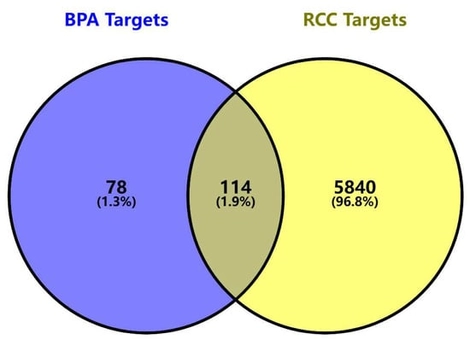- Article
Toxicological Impacts and Mechanistic Insights of Bisphenol a on Clear Cell Renal Cell Carcinoma Progression: A Network Toxicology, Machine Learning and Molecular Docking Study
- Jie Chen,
- Biao Ran and
- Bo Chen
- + 10 authors
Background: Clear cell renal cell carcinoma (ccRCC) is a prevalent urological malignancy, accounting for approximately 1.6% of all cancer-related deaths in 2022. While endocrine-disrupting chemicals (EDCs) have been implicated as risk factors for ccRCC, the toxicological profiles and immune mechanisms underlying Bisphenol A (BPA) exposure in ccRCC progression remain inadequately understood. Materials and Methods: Protein–protein interaction (PPI) analysis and visualization were performed on overlapping genes between ccRCC and BPA exposure. This was followed by Gene Ontology (GO) and Kyoto Encyclopedia of Genes and Genomes (KEGG) enrichment analyses to elucidate potential underlying mechanisms. Subsequently, 108 distinct machine learning algorithm combinations were evaluated to identify the optimal predictive model. An integrated CoxBoost and Ridge regression model was constructed to develop a prognostic signature, the performance of which was rigorously validated across two independent external datasets. Finally, molecular docking analyses were employed to investigate interactions between key genes and BPA. Results: A total of 114 overlapping targets associated with both ccRCC and BPA were identified. GO and KEGG analyses revealed enrichment in cancer-related pathways, including pathways in cancer, endocrine resistance, PD-L1 expression and PD-1 checkpoint signaling, T-cell receptor signaling, endocrine function, and immune responses. Machine learning algorithm selection identified the combined CoxBoost-Ridge approach as the optimal predictive model (achieving a training set concordance index (C-index) of 0.77). This model identified eight key genes (CHRM3, GABBR1, CCR4, KCNN4, PRKCE, CYP2C9, HPGD, FASN), which were the top-ranked by coefficient magnitude in the prognostic model. The prognostic signature demonstrated robust predictive performance in two independent external validation cohorts (C-index = 0.74 in cBioPortal; C-index = 0.81 in E-MTAB-1980). Furthermore, molecular docking analyses predicted strong binding affinities between BPA and these key targets (Vina scores all <−6.5 kcal/mol), suggesting a potential mechanism through which BPA may modulate their activity to promote renal carcinogenesis. Collectively, These findings suggested potential molecular mechanisms that may underpin BPA-induced ccRCC progression, generating hypotheses for future experimental validation. Conclusions: These findings enhance our understanding of the molecular mechanisms by which BPA induces ccRCC and highlight potential targets for therapeutic intervention, particularly in endocrine and immune-related pathways. This underscores the need for collaborative efforts to mitigate the impact of environmental toxins like BPA on public health.
13 November 2025




